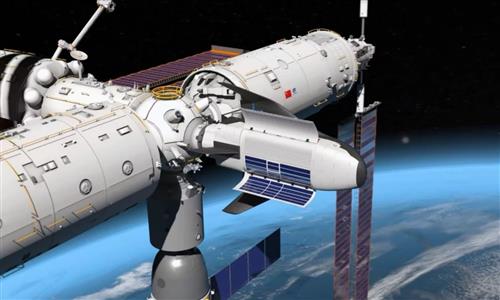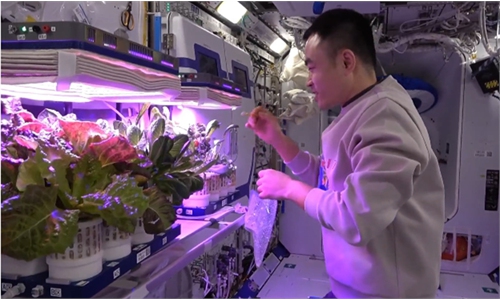Qingzhou cargo spacecraft debuts amid Space Day celebrations
Small but strong and smart deliveryman set for inaugural flight: chief designer

Photo: Deng Xiaoci/GT
Qingzhou, China's next-generation cargo spacecraft designed for future in-orbit supply delivery including to the China Space Station, makes its public debut in Shanghai on Thursday, with a life-size model of the spacecraft on display amid celebrations of this year's Space Day of China. The Global Times sat down with the spacecraft Chief Designer Chang Liang in an exclusive interview to learn more about this small yet strong space deliveryman.
It is set to take its inaugural flight this year, and the development team is currently working on the design as well as the software for the initial test of the spacecraft. Production has also already begun on the subsystems and components of the initial test spacecraft, Chang revealed.
Qingzhou, which means "Light Ship" in Chinese, has been designed to be smaller in size and lighter in weight, compared to the existing Tianzhou (Sky Ship) cargo spacecraft.
Compared with traditional cargo spacecraft which typically adopt dual-module or multi-module configurations, Qingzhou's key innovation lies in reducing the propulsion module and making the cargo module expandable, thereby increasing the versatility in both the types and quantity of cargo it can carry, Chang explained to the Global Times.
The Qingzhou chief designer went on to say that while meeting mission requirements, such integrated single-module configuration enhances space utilization and improves mission cost-effectiveness, reducing Qingzhou's overall dimensions, maximizing usable space for cargo, and providing taikonauts with a convenient and efficient operating area.
Small frame, mighty capabilities
According to Chang, at the design stage, the development team has studied cargo spacecraft, both domestic and international, including the US Dragon spacecraft, Europe's ATV, Japan's HTV and China's Tianzhou series. Ultimately, based on the spatial requirements issued by the China Manned Space Agency (CMSA), they independently designed and developed the compact, integrated Qingzhou cargo spacecraft.
The Qingzhou cargo spacecraft, developed by the Shanghai-based Innovation Academy for Microsatellites of the Chinese Academy of Sciences (IAMCAS), features an integrated single-capsule configuration with a cargo volume of up to 27 cubic meters. This expansive capacity is set to significantly cut cargo transportation costs and enhance flexibility in logistics, per Xinhua.
It also allows for greater flexibility in launch vehicle selection, making it compatible with multiple rocket types and supporting rapid launch needs, he added.
Qingzhou currently has an upload capacity of over 1.8 tons and a downlink capacity of 2 tons, which is designed according to the needs of the taikonaut crew and the requirement for returning waste. In the future, its cargo potential will be further explored, with transport capacity expandable according to mission demands.
Chang revealed that Qingzhou spacecraft adopts a four-tier shelving system with a total of 40 cargo compartments, meeting the transport needs for crew life support supplies, scientific experiment equipment and more.
For special cargo requirements, dedicated interfaces have been reserved in the shelf design to accommodate specific uplink needs. Qingzhou's loading volume is approximately 9 cubic meters, while the total cargo module volume is 27 cubic meters.
Smart spacecraft
The design of the Qingzhou also manifests multiple innovations, making it a genuinely smart spacecraft.
Multiple high-definition cameras are installed throughout the Qingzhou spacecraft to enable full-range monitoring. Using intelligent visual algorithms, the system directly records when taikonauts retrieve cargo packages and automatically updates the cargo database.
Furthermore, an integrated voice system is connected to the database, allowing taikonauts to search for specific items in various ways. The system then assists in identifying the corresponding cargo package and its location.
The spacecraft also involves a cold-chain container system with flexible configuration at its core. Each unit has a capacity of 60 liters, and the number of containers can be adjusted based on cold-chain upload requirements.
The temperature zones within the cold-chain containers can be precisely regulated to meet the storage needs of different types of cargo. These design features significantly enhance the reliability and stability of cold-chain transport, ensuring the freshness of uploading goods, according to Chang.
Leveraging the scientific innovation experience from earlier projects and the traditional advantages of small satellites, Qingzhou plans to carry out in-orbit experiments with scientific payloads after completing its cargo transport mission. Before re-entering the atmosphere, Qingzhou can also carry and deploy small satellites in orbit, he said.
Qingzhou spacecraft incorporates commercial spaceflight concepts and technical approaches, Chang said. "For example, we are the first to adopt a cargo transport system as the central element of a commercially driven model, enabling a more integrated approach between the cargo delivery and spacecraft."
By embracing commercial space philosophies, we aim to accelerate the adoption and iteration of new ideas, components and materials within the space sector, generating both economic and social value. We also plan to explore a variety of commercial models, including naming rights, cultural IP payloads, brand promotion and science communication partnerships. Through innovative collaboration with diverse industries, we seek to foster broader engagement and deliver tangible benefits to society, Chang visioned.
According to Xinhua, the Qingzhou cargo spacecraft is scheduled to be launched by the Lijian-2 rocket, which is manufactured by CAS Space.
Responding to Global Times reporters' question on why the Lijian-2 has been chosen as the launch vehicle for the Qingzhou spacecraft and how the two are integrated in terms of structural design, operations and telemetry as well as control, Chang remarked that Lijian-2 is a new type of liquid kerosene launch vehicle with a payload capacity ranging from 8 to 12 tons, providing support for the future expansion of Qingzhou.
Lijian-2 is designed to be a reusable rocket in the future, aligning with the commercial spaceflight concept of a low-cost cargo transport system. Structurally, the rocket and Qingzhou are also co-optimized in an integrated design, Chang said.
Chang and his team are working round the clock to advance relevant work for the inaugural flight.
"Compared to traditional satellites, cargo spacecraft for the crewed spaceflight system have more complex functional requirements and stricter reliability standards. Under the leadership of the CMSA, and with established standards and the support of various systems, we are confident that we will overcome challenges and successfully complete the tasks of flight, docking and cargo delivery," Chang said.




